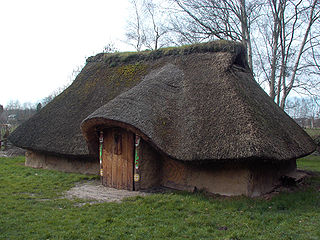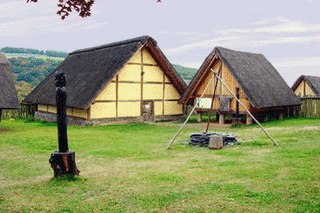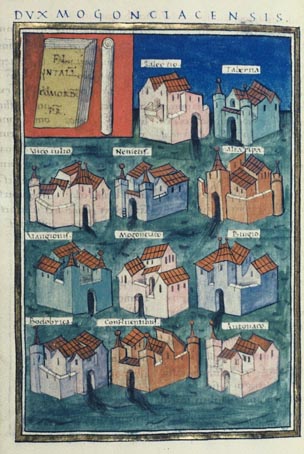In classical antiquity, the Triboci or Tribocci were a Germanic people of eastern Gaul, inhabiting much of what is now Alsace.
In classical antiquity, the Triboci or Tribocci were a Germanic people of eastern Gaul, inhabiting much of what is now Alsace.
Besides the forms Triboci and Tribocci, Schneider has the form “Triboces” in the accusative plural. [1] Pliny has Tribochi, and Strabo Τριβόκχοι(Tribokchoi). In the passage of Caesar, it is said that all manuscripts have “Tribucorum”. [2] "Three beeches" (Celtic tri, Germanic boc) has been suggested as an etymology, as has Germanic dribòn ("drivers [of cattle, livestock]"). [3] [4] [5]
Ptolemy places the Tribocci in Germania Superior, but he incorrectly places the Vangiones between the Nemetes and the Tribocci, for the Nemetes bordered on the Tribocci. However he places the Tribocci next to the Rauraci, and he names Breucomagus (Brocomagus, today's Brumath) and Elcebus (Helcebus) as the two towns of the Tribocci, making Argentoratum (Strasbourg) a city of the Vangiones. [6] D'Anville supposes that the territory of the Tribocci corresponded to the mediaeval diocese of Strasbourg. Consequently, a Tribocci burial ground was excavated in Diersheim on the right bank of the Rhine in today's Germany.http://dl.ub.uni-freiburg.de/diglit/ortenau1977/0011/ocr?sid=9959984406c34fcd88a0a3f26001cbdf Saletio (Seltz), we may suppose, belonged to the Nemetes, as in modern times it belonged to the diocese of Speyer; and it is near the northern limits of the diocese of Strasbourg. On the south towards the Rauraci, a place named Marckolsheim, on the southern limit of the diocese of Strasbourg and bordering on that of Basel, indicates a boundary by a Teutonic name (mark), as fines does in those parts of Gaul where the Roman tongue prevailed. The name of the Tribocci does not appear in the Notitia provinciarum Galliae , though the names of the Nemetes and Vangiones are there; but instead of the Tribocci we have Civitas Argentoratum (Strasbourg), the chief place of the Tribocci.
The Triboci were in the army of the Germanic king Ariovistus in the great battle in which Julius Caesar defeated him; and though Caesar does not say directly that they were Germans, his narrative shows that he considered them to be Germans. [7] In another passage Caesar places the Triboci on the Rhine between the Mediomatrici and the Treviri, and he means to place them on the left or Gallic side of the Rhine. [8] Strabo, after mentioning the Sequani and Mediomatrici as extending to the Rhine, says, “Among them a German people has settled, the Tribocchi, who have passed over from their native land.” [9] Pliny and Tacitus say that the Tribocci are Germans. [10] [11] The true conclusion from Caesar is that he supposed the Tribocci to be settled in Gallia before 58 BCE.
Nero Claudius Drusus established a military camp at Argentorate (Strasbourg) in 12 BCE, near which there had already been a civilian La Tène settlement since around 100 BCE. [12]
The Triboci joined the revolt of Civilis in 70 CE, sending reinforcements to the Treveran rebel commander Julius Tutor along with the Caeracates, Vangiones and dissident Romans. This combined force defeated a Roman cohort, but at the approach of the main body of the Roman army, these new reinforcements, including the Triboci, defected to the Roman side. [13]
The city of Argentorate was rebuilt in 97 under Trajan after a fire. [12]

The Helvetii, anglicized as Helvetians, were a Celtic tribe or tribal confederation occupying most of the Swiss plateau at the time of their contact with the Roman Republic in the 1st century BC. According to Julius Caesar, the Helvetians were divided into four subgroups or pagi. Of these, Caesar names only the Verbigeni and the Tigurini, while Posidonius mentions the Tigurini and the Tougeni (Τωυγενοί). They feature prominently in the Commentaries on the Gallic War, with their failed migration attempt to southwestern Gaul serving as a catalyst for Caesar's conquest of Gaul.

The Suebi were a large group of Germanic peoples originally from the Elbe river region in what is now Germany and the Czech Republic. In the early Roman era they included many peoples with their own names such as the Marcomanni, Quadi, Hermunduri, Semnones, and Lombards. New groupings formed later, such as the Alamanni and Bavarians, and two kingdoms in the Migration Period were simply referred to as Suebian.

Batavia is a historical and geographical region in the Netherlands, forming large fertile islands in the river delta formed by the waters of the Rhine and Meuse rivers. During the Roman empire, it was an important frontier region and source of imperial soldiers. Its name is possibly pre-Roman.

The Cherusci were a Germanic tribe that inhabited parts of the plains and forests of northwestern Germany in the area of the Weser River and present-day Hanover during the first centuries BC and AD. Roman sources reported they considered themselves kin with other Irmino tribes and claimed common descent from an ancestor called Mannus. During the early Roman Empire under Augustus, the Cherusci first served as allies of Rome and sent sons of their chieftains to receive Roman education and serve in the Roman army as auxiliaries. The Cherusci leader Arminius led a confederation of tribes in the ambush that destroyed three Roman legions in the Teutoburg Forest in AD 9. He was subsequently kept from further damaging Rome by disputes with the Marcomanni and reprisal attacks led by Germanicus. After rebel Cherusci killed Arminius in AD 21, infighting among the royal family led to the highly Romanized line of his brother Flavus coming to power. Following their defeat by the Chatti around AD 88, the Cherusci do not appear in further accounts of the German tribes, apparently being absorbed into the late classical groups such as the Saxons, Thuringians, Franks, Bavarians, and Allemanni.

Germania, also called Magna Germania, Germania Libera, or Germanic Barbaricum to distinguish it from the Roman province of the same name, was a large historical region in north-central Europe during the Roman era, which was associated by Roman authors with the Germanic peoples. The region stretched roughly from the Middle and Lower Rhine in the west to the Vistula in the east. It also extended as far south as the Upper and Middle Danube and Pannonia, and to the known parts of Scandinavia in the north. Archaeologically, these peoples correspond roughly to the Roman Iron Age of those regions. While apparently dominated by Germanic peoples, Magna Germania was also inhabited by other Indo-European peoples.

The Nervii were one of the most powerful Belgic tribes of northern Gaul at the time of its conquest by Rome. Their territory corresponds to the central part of modern Belgium, including Brussels, and stretched southwards into French Hainault. During their first century BC Roman military campaign, Julius Caesar's contacts among the Remi stated that the Nervii were the most warlike of the Belgae. In times of war, they were known to trek long distances to take part in battles. Being one of the northerly Belgic tribes, with the Menapii to the west, and the Eburones to their east, they were considered by Caesar to be relatively uncorrupted by civilization. According to Tacitus they claimed Germanic descent. According to Strabo they were of Germanic origin.

The Menapii were a Belgic tribe dwelling near the North Sea, around present-day Cassel, during the Iron Age and the Roman period.

The Usipetes or Usipii were an ancient tribe who moved into the area on the right bank of the lower Rhine in the first century BC, putting them in contact with Gaul and the Roman empire. They are known first from the surviving works of ancient authors such as Julius Caesar and Tacitus. They appear to have moved position several times before disappearing from the historical record.

Ariovistus was a leader of the Suebi and other allied Germanic peoples in the second quarter of the 1st century BC. He and his followers took part in a war in Gaul, assisting the Arverni and Sequani in defeating their rivals, the Aedui. They then settled in large numbers into conquered Gallic territory, in the Alsace region. They were defeated, however, in the Battle of Vosges and driven back over the Rhine in 58 BC by Julius Caesar.

The Tungri were a tribe, or group of tribes, who lived in the Belgic part of Gaul, during the times of the Roman Empire. Within the Roman Empire, their territory was called the Civitas Tungrorum. They were described by Tacitus as being the same people who were first called "Germani" (Germanic), meaning that all other tribes who were later referred to this way, including those in Germania east of the river Rhine, were named after them. More specifically, Tacitus was thereby equating the Tungri with the "Germani Cisrhenani" described generations earlier by Julius Caesar. Their name is the source of several place names in Belgium, Germany and the Netherlands, including Tongeren, Tongerlo Abbey, and Tongelre.

The Trēverī were a Celtic tribe of the Belgae group who inhabited the lower valley of the Moselle in modern day Germany from around 150 BCE, if not earlier, until their displacement by the Franks. Their domain lay within the southern fringes of the Silva Arduenna, a part of the vast Silva Carbonaria, in what are now Luxembourg, southeastern Belgium and western Germany; its centre was the city of Trier, to which the Treveri give their name. Celtic in language, according to Tacitus they claimed Germanic descent. They possibly contained both Gallic and Germanic influences.

The Sicambri, also known as the Sugambri or Sicambrians, were a Germanic people who during Roman times lived on the east bank of the river Rhine, in what is now Germany, near the border with the Netherlands. They were first reported by Julius Caesar, who described them as Germanic (Germani), though he did not necessarily define this in terms of language.

The Vangiones appear first in history as an ancient Germanic tribe of unknown provenance. They threw in their lot with Ariovistus in his bid of 58 BC to invade Gaul through the Doubs river valley and lost to Julius Caesar in a battle probably near Belfort. After some Celts evacuated the region in fear of the Suebi, the Vangiones, who had made a Roman peace, were allowed to settle among the Mediomatrici in northern Alsace.. They gradually assumed control of the Celtic city of Burbetomagus, later Worms.

The Sequani were a Gallic tribe dwelling in the upper river basin of the Arar river (Saône), the valley of the Doubs and the Jura Mountains during the Iron Age and the Roman period.
The Hercynian Forest was an ancient and dense forest that stretched across Western Central Europe, from Northeastern France to the Carpathian Mountains, including most of Southern Germany, however its boundaries are a matter of debate. It formed the northern boundary of that part of Europe known to writers of Antiquity. The ancient sources are equivocal about how far east it extended. Many agree that the Black Forest, which extended east from the Rhine valley, formed the western side of the Hercynian, except, for example, Lucius of Tongeren. According to him, it included many massifs west of the Rhine.

The Battle of Vosges, also referred to as the Battle of Vesontio, was fought on September 14, 58 BC between the Germanic tribe of the Suebi, under the leadership of Ariovistus, and six Roman legions under the command of Gaius Julius Caesar. This encounter is the third major battle of the Gallic Wars. Germanic tribes crossed the Rhine, seeking a home in Gaul.

The Nemetes E.g. Frederick Kohlrausch "History of Germany. From the Earliest Period to the Present Time". D.Appleton and Company, New York, 1880. were a tribe settled along the Upper Rhine by Ariovistus in the 1st century BC.

The Mediomatrici were according to Caesar a Gaulish tribe at the frontier to the Belgicae dwelling in the present-day regions Lorraine, Upper Moselle during the Iron Age and the Roman period.
The Germani cisrhenani, or "Left bank Germani", were a group of Germanic peoples who lived west of the Lower Rhine at the time of the Gallic Wars in the mid-1st century BC.
The Battle of Magetobriga was fought in 63 BC between rival tribes in Gaul. The Aedui tribe was defeated and massacred by the combined forces of their hereditary rivals, the Sequani and Arverni tribes, who had enlisted the aid of the Germanic Suebi tribe under their king Ariovistus. Following their defeat, the Aedui sent envoys to the Roman Senate, their traditional ally, for aid. The Roman general Julius Caesar would subsequently use their request for aid as a basis for furthering his conquest of Gaul.
{{cite encyclopedia}}: Missing or empty |title= (help)